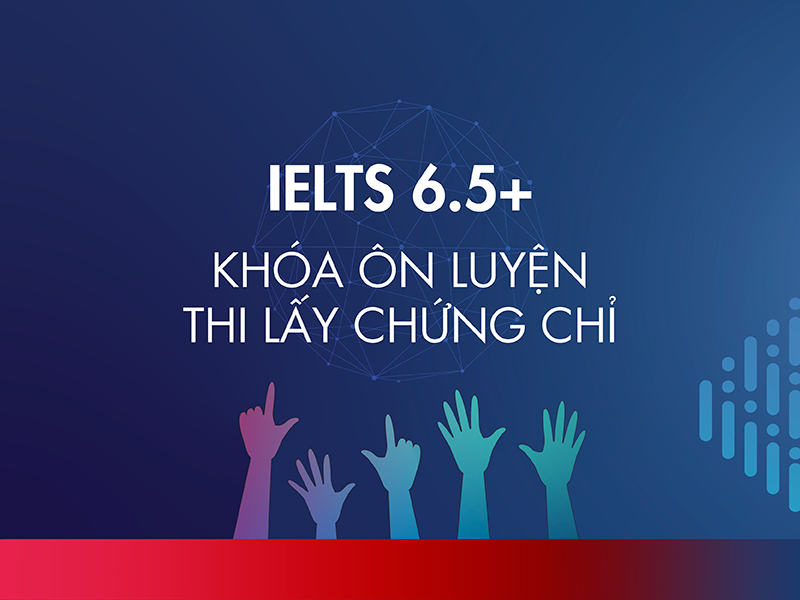
Khóa Ôn luyện thi lấy chứng chỉ
Course material: Mindset for IELTS – Book 3
Course length: 12 weeks (4 meetings/ week) = 120 hours
Vietnamese/ Native rate: 36 meetings (108 periods) / 12 meetings (30 periods)
SUPPLEMENT:
Reading: Improve your skills (Reading for IELTS 6.0-7.5)
Listening: Improve your skills (Speaking and Listening for IELTS 6.0-7.5) + IELTS Masterclass (Level C1 CEFR)
Speaking: Improve your skills (Speaking and Listening for IELTS 6.0-7.5)
Writing: Improve your skills (Writing 6.0-7.5)
Cambridge IELTS Book 12
At the end of this course, students will be able to:
- refine their knowledge of Listening section 1 (spelling, numbers, factual information for note completion tasks) and section 2 (listening for details to do diagram completion tasks and table completion);
- skillfully use the skills (e.g., identifying distractors, signposting, understanding speaker’s attitude, using notes, paraphrasing, etc.) to deal with questions in Part 3 and Part 4 of the Listening test, the main focuses of this course;
- use academic vocabulary, collocations, and ideas from listening input for speaking about related topics;
- correctly answer at least 27 out of 40 questions within 60 minutes of the Listening test.
At the end of this course, students will be able to:
- expand their’ stock of vocabulary related to common IELTS topics such as work and life, health, art and architecture, finance and business, history, science and technology, media, culture;
- develop their ability to give extended answers for Part 1, Part 2, and Part 3 of the IELTS Speaking test, but the main focus is on Part 3
- use a range of speaking skills effectively to answer Part 2 questions (e.g., making notes for long-turn answers, using discourse markers for idea organization) and Part 3 questions (expressing opinions in different ways, making generalizations, clarifications, proper hesitation, avoiding repetition, and speculating)
- produce speech with a high level of phrasal and sentential accuracy and complexity; the focus is on complex sentence structures;
- use appropriate pronunciation and intonation (e.g., syllable stress, discourse markers, modals of obligation, sentence stress, chunking, schwa sounds, etc.)
At the end of this course, students will be able to:
- familiarize themselves with such top-down reading skills as (1) identifying main ideas and supporting ideas; (2) developing whole-text understanding; (3) identifying writer’s claims and views; (4) locating information
- effectively use bottom-up reading skills (e.g., identifying the meaning of prefixes, paraphrasing) to support their understanding of texts
- master the strategies necessary for dealing with Reading question types: Matching headings, features, and sentence endings; Multiple choice questions with multiple or single answers; Completion questions (sentence completion, note completion, summary completion); and T/F/NG or Y/N/NG questions
- correctly answer at least 26 out of 40 questions within 60 minutes of the Reading test
At the end of this course, students will be able to:
TASK 1
- write a complete, well-organized report (150-200 words) describing data represented in trend figures and comparative figures
- use a holistic approach to analysing Task 1 illustrations with and without data
- refine their knowledge and use of language for describing trends and comparative information; and use some less common vocabulary and comparative structures
- improve their skills for dealing with complex man-made process diagrams and map diagrams
TASK 2
- write a complete, well-organized essay (250-300 words) discussing advantages/disadvantages, solutions, balanced opinions, and opposing opinions. The focal essay type is balanced opinion.
- use a holistic approach to analysing Task 2 essay questions to cope with Task Response requirements
- refine their use of language for describing advantages / disadvantages, and solutions
- apply advanced language for expressing balanced opinions and opposing opinions
- use some less common vocabulary and complex structures in writing
- develop their skills for using academic English styles (i.e., softening and hedging, fronting sentences…)